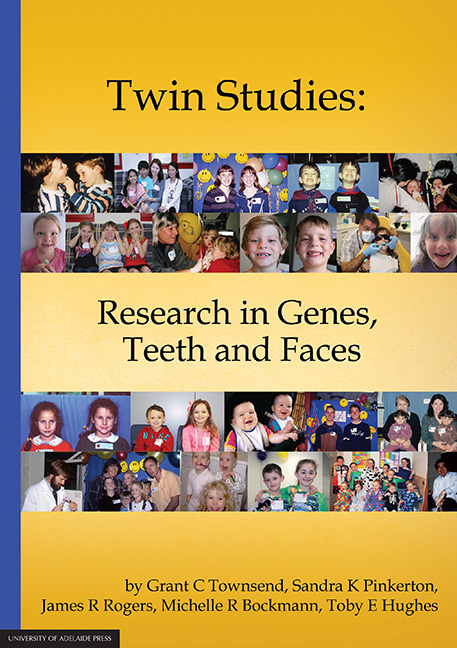Book contents
- Frontmatter
- Foreword
- Preface
- Dedication
- Photographic acknowledgements
- Ethical approval
- Acknowledgements
- Contents
- Chapter One A tour of the mouth
- Chapter Two A historical perspective
- Chapter Three Phases of research involving twin studies of teeth and faces
- Chapter Four Cohort 1: Teeth and faces of South Australian teenage twins
- Chapter Five Cohort 2 – A longitudinal study of dental and facial development in Australian twins and their families
- Chapter Six Cohort 3 – Tooth emergence and oral health in Australian twins and their families
- Chapter Seven Publications and theses relating to the Adelaide Twin Studies
- Glossary of terms
- Appendix 1
Chapter Five - Cohort 2 – A longitudinal study of dental and facial development in Australian twins and their families
Published online by Cambridge University Press: 05 February 2016
- Frontmatter
- Foreword
- Preface
- Dedication
- Photographic acknowledgements
- Ethical approval
- Acknowledgements
- Contents
- Chapter One A tour of the mouth
- Chapter Two A historical perspective
- Chapter Three Phases of research involving twin studies of teeth and faces
- Chapter Four Cohort 1: Teeth and faces of South Australian teenage twins
- Chapter Five Cohort 2 – A longitudinal study of dental and facial development in Australian twins and their families
- Chapter Six Cohort 3 – Tooth emergence and oral health in Australian twins and their families
- Chapter Seven Publications and theses relating to the Adelaide Twin Studies
- Glossary of terms
- Appendix 1
Summary
Introduction
In 1994 the Craniofacial Biology Group decided that it would be valuable to carry out a comprehensive study of dental and facial development and morphology in young twins in the 4-6-year-old age interval to supplement previous studies of teenage twins. At that time, there had been no detailed studies of the teeth or faces of young twins with primary (deciduous) teeth. It was also not known whether special features of the twinning process affected dental and facial features of young twins. It was planned, if funding allowed, to re-examine these twins again around the ages of 9 to 11 years and then at around 12 to 14 years of age. This would then become one of the few longitudinal studies of twins focusing on teeth and faces to be carried out worldwide.
The aim in setting up this study of young twins, who are now referred to as Cohort 2, was to extend the use of newly developed methods of genetic model-fitting to data obtained from teeth and faces of both monozygotic and dizygotic twins, so that we could clarify in more detail than previously the roles of genetic and environmental determinants on observed variation. We also aimed to compare the expression of bilateral dental and facial features on the right and left sides, in both twins and singletons, to see the extent to which the twinning process affects the determination of body symmetry. This included our desire to explore more fully the fascinating phenomenon of mirror imaging, where one twin of a pair mirrors the other for one or more features.
As has been emphasised earlier, the primary teeth provide an excellent model system to study genetic aspects of dental and facial development. They also have advantages for investigating some of the questions relating to observed developmental differences between dental and facial features on the right and left sides (disturbed laterality) thought to be associated with the twinning process.
Most of the development of the primary tooth crowns occurs between approximately four weeks in utero and birth, with all the crowns being completely formed by around twelve months postnatally. This developmental span enables an assessment of how various pre- and perinatal factors, such as maternal health, smoking and alcohol consumption, placenta type and birth weight, might influence dental structures.
- Type
- Chapter
- Information
- Twin StudiesResearch in Genes, Teeth and Faces, pp. 113 - 134Publisher: The University of Adelaide PressPrint publication year: 2015



